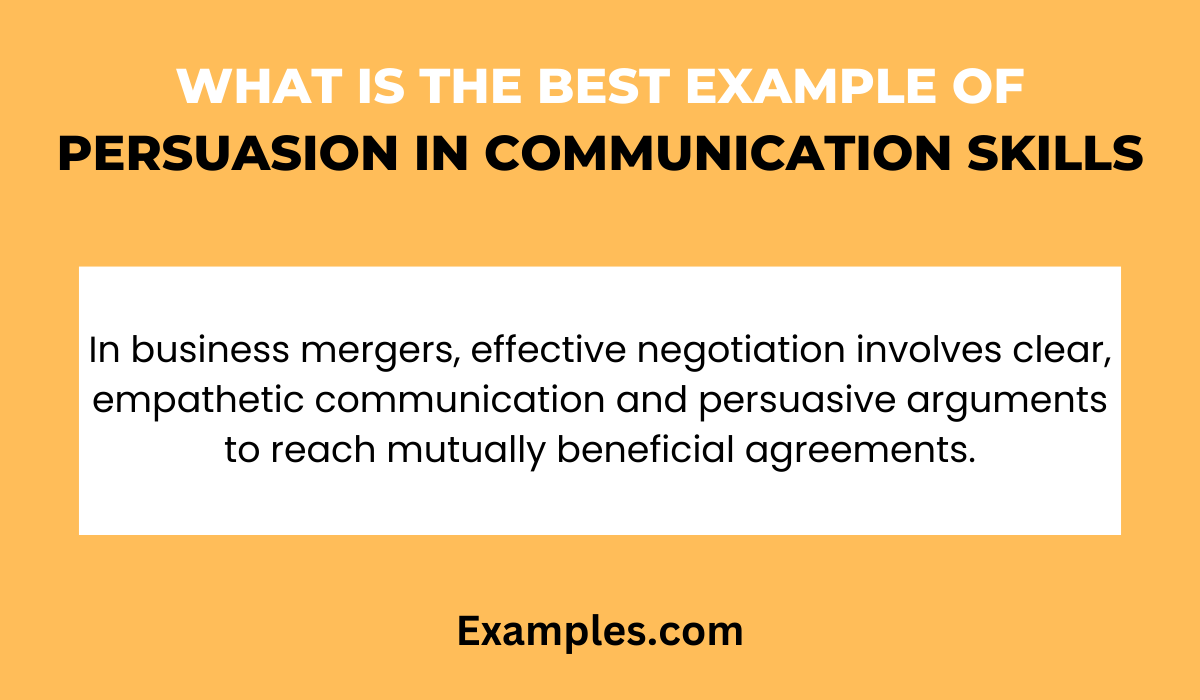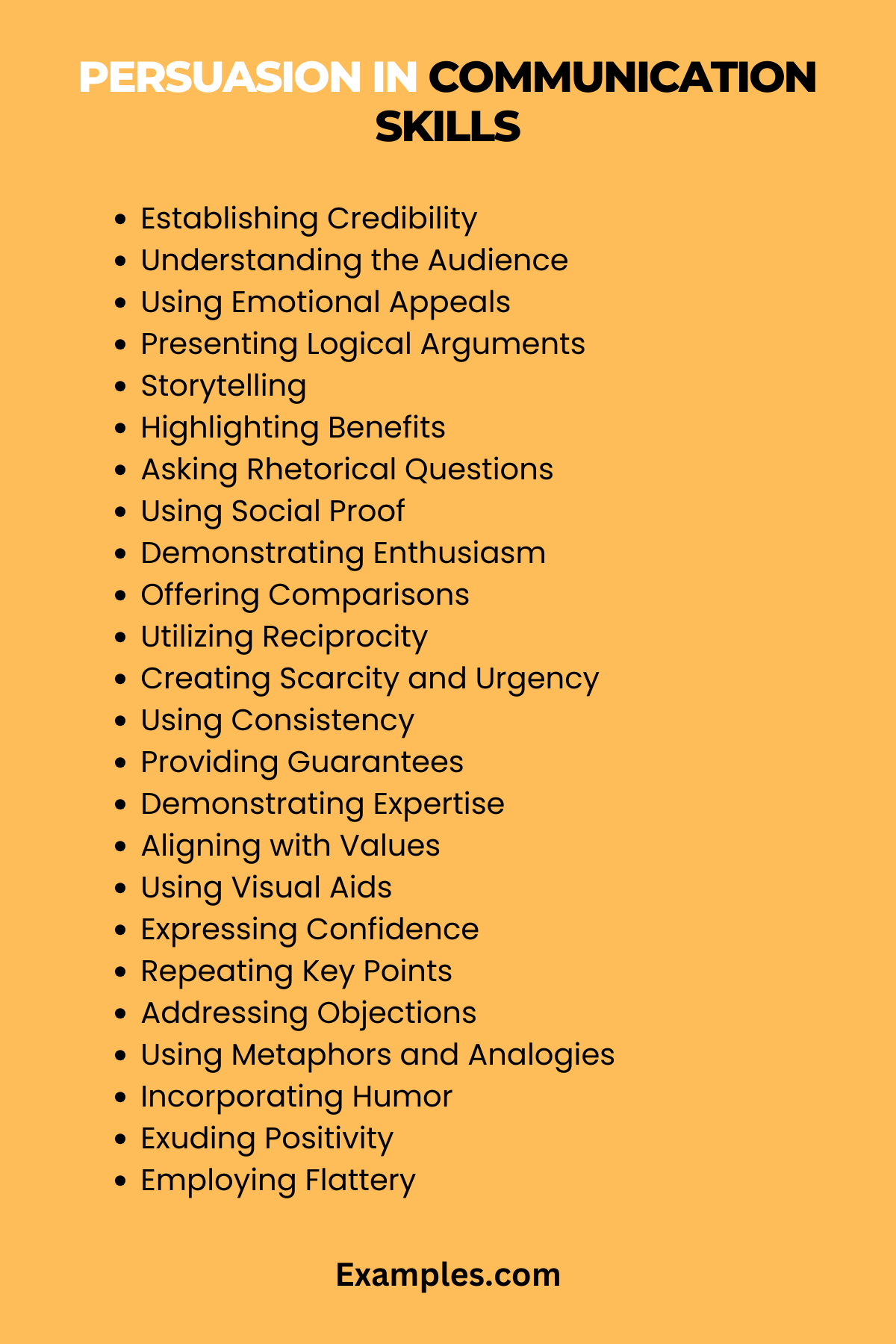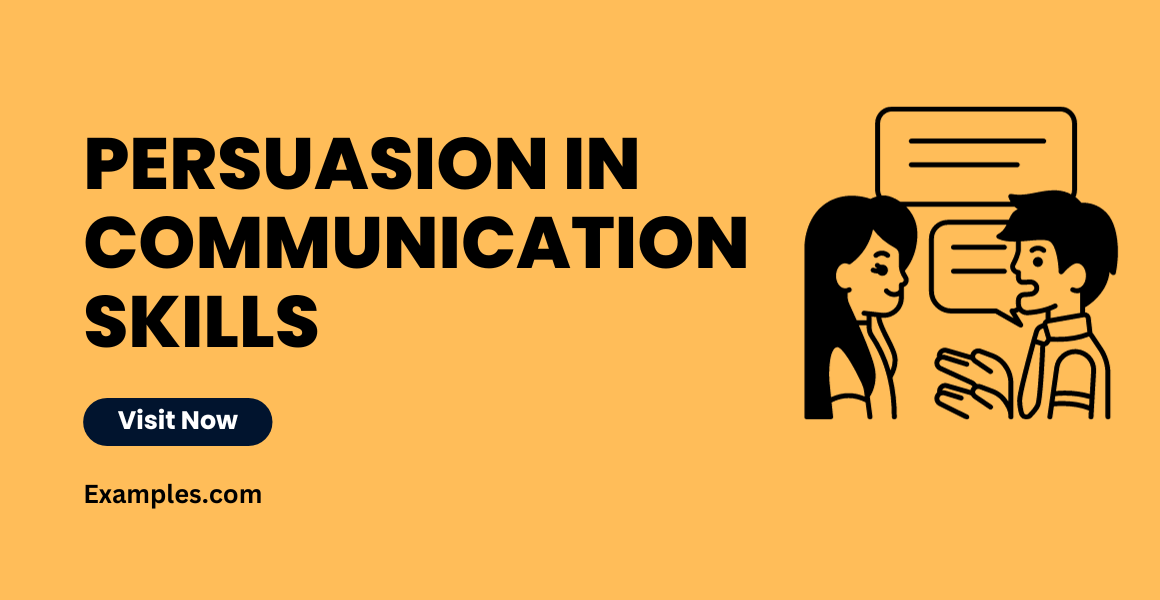29+ Persuasion in Communication Skills Examples
In the ever-evolving world of marketing, Brand Communication stands out as a critical pillar. This guide delves into its nuances, offering a comprehensive look at how brands convey their message, ethos, and values. Incorporating various Communication Examples, we explore the strategies and techniques that make brand communication effective and resonant. From crafting compelling narratives to engaging with audiences, this guide is a treasure trove for marketers and businesses aiming to strengthen their brand’s voice.
What is Persuasion in Communication Skills?
Persuasion in Communication Skills refers to the ability to influence others’ attitudes, beliefs, or behaviors through effective communication. It involves the use of logic, reasoning, emotion, and ethical appeals to convince an audience. This skill is fundamental in various contexts, including sales, marketing, politics, and everyday interactions, where convincing others is key to achieving objectives.

What is the Best Example of Persuasion in Communication Skills?
A standout example of Persuasion in Communication Skills is seen in successful advertising campaigns. These campaigns skillfully combine emotional appeal, logical arguments, and credibility to influence consumer behavior and attitudes toward a product or brand. For instance, an ad that convinces consumers to switch to a new brand by highlighting its unique benefits, testimonials from satisfied customers, and data supporting its superiority demonstrates effective persuasion in action.

30 Persuasion in Communication Skills
Persuasion in Communication Skills is an art that combines the power of influence with effective communication techniques. This guide offers 30 key persuasive skills, each accompanied by a distinct example to illustrate how these techniques can be applied in various scenarios. From using emotional appeals to logical reasoning, these skills will enhance your ability to persuade effectively, making your communication more impactful and successful.

- Establishing Credibility: Build trust by showcasing your expertise or experience.
Example: “With my 10 years of experience in this field, I recommend this approach.” - Understanding the Audience: Tailor your message to resonate with your audience’s values and beliefs.
Example: “As parents, we all want what’s best for our children, which is why I suggest this program.” - Using Emotional Appeals: Connect emotionally to make your message more compelling.
Example: “Imagine the relief and happiness you’ll feel achieving this goal.” - Presenting Logical Arguments: Support your points with logical reasoning and evidence.
Example: “Statistics show a 30% improvement when using this method.” - Storytelling: Share relevant stories to illustrate your points vividly.
Example: “Let me tell you about a client who benefited immensely from this approach.” - Highlighting Benefits: Emphasize the benefits of your proposal to the audience.
Example: “By adopting this plan, you’ll save both time and money.” - Asking Rhetorical Questions: Pose questions that provoke thought and engagement.
Example: “Have you ever considered the incredible impact of making this change?”

- Using Social Proof: Cite testimonials or examples of others who have agreed.
Example: “Leading experts in our field have endorsed this approach.” - Demonstrating Enthusiasm: Show passion and enthusiasm about your message.
Example: “I am incredibly excited about the potential of this project!” - Offering Comparisons: Compare your idea with others to highlight its superiority.
Example: “Unlike other products, ours offers more features and better quality.” - Utilizing Reciprocity: Suggest that your proposal will lead to mutual benefits.
Example: “This partnership will be highly beneficial for both our organizations.” - Creating Scarcity and Urgency: Imply that action is needed quickly due to limited availability.
Example: “This opportunity won’t last forever; we need to act now.” - Using Consistency: Align your message with the audience’s existing beliefs or past actions.
Example: “Since you’ve always valued innovation, this new approach is perfect for you.” - Providing Guarantees: Offer assurances to alleviate any concerns.
Example: “We guarantee satisfaction with our service, or your money back.” - Demonstrating Expertise: Share your knowledge to enhance your persuasiveness.
Example: “Based on my extensive research, this is the best course of action.” - Aligning with Values: Connect your message to the audience’s core values.
Example: “This aligns perfectly with our shared commitment to sustainability.” - Using Visual Aids: Enhance your message with impactful visuals.
Example: “As shown in this chart, our results are unparalleled.” - Expressing Confidence: Communicate with confidence to persuade effectively.
Example: “I am confident that this is the right decision for us.” - Repeating Key Points: Reinforce your message through repetition.
Example: “Remember, this strategy increases efficiency, which is crucial for us.” - Addressing Objections: Preemptively address potential concerns.
Example: “You might worry about the cost, but the long-term benefits outweigh it.”

- Using Metaphors and Analogies: Make complex ideas more relatable.
Example: “Navigating this change is like steering a ship to new horizons.” - Incorporating Humor: Light humor can make your message more engaging.
Example: “This solution is so simple, even I managed to get it right the first time!” - Exuding Positivity: Maintain a positive tone throughout your message.
Example: “I’m positive that we’re on the brink of something great.” - Employing Flattery: Appropriately flatter your audience to gain favor.
Example: “With your renowned expertise, this project’s success is inevitable.” - Simplifying Complex Information: Break down complex ideas into understandable terms.
Example: “In simple terms, this means more benefits with less investment.” - Using Inclusive Language: Make the audience feel part of the idea.
Example: “Together, we can make this vision a reality.” - Appealing to Authority: Reference authoritative sources to back up your claims.
Example: “Leading scientists have validated this approach in recent studies.” - Challenging Assumptions: Encourage the audience to rethink existing beliefs.
Example: “What if there’s a better way than what we’re used to?” - Providing Testimonials: Share testimonials to build trust in your proposal.
Example: “Many have seen remarkable improvements using this method, just listen to their stories.” - Encouraging Participation: Involve your audience in the discussion.
Example: “I’d love to hear your thoughts on how we can implement this together.”
Persuasive Strategies in Communication
Understanding and implementing effective Persuasive strategies in communication is key to influencing and guiding the opinions and actions of others. This section explores various techniques and approaches to persuasively communicate your ideas and messages.
- Using Emotional Appeals: Connect with your audience on an emotional level for stronger impact.
- Establishing Credibility: Build trust by demonstrating your knowledge and expertise.
- Storytelling: Utilize engaging stories to make your points more relatable and memorable.
- Logical Reasoning: Back up your arguments with clear logic and factual data.
- Understanding the Audience: Tailor your message to align with the audience’s beliefs and values.
- Repetition: Reinforce key points through repetition to enhance message retention.
- Social Proof: Use testimonials and endorsements to validate your claims.
- Contrast Technique: Highlight the differences between options to clarify your position.
- Scarcity and Urgency: Create a sense of urgency to prompt immediate action.
- Asking Questions: Use strategic questions to lead the audience to your viewpoint.
Importance of Persuasion in Communication Skills
The Importance of Persuasion in Communication Skills lies in its ability to effectively influence and motivate others. Persuasion is a critical component in various aspects of personal and professional life, making its mastery invaluable.
- Influencing Decisions: Persuasion is key in shaping decisions and opinions.
- Career Advancement: Effective persuasion skills can lead to professional growth and opportunities.
- Enhancing Leadership: Leaders benefit from persuasion to inspire and lead their teams.
- Facilitating Negotiations: Persuasion is essential in successful negotiation outcomes.
- Strengthening Relationships: Persuasion skills can help in building and maintaining healthy relationships.
- Effective Marketing: In business, persuasion is crucial for marketing and sales.
- Conflict Resolution: Persuasive communication aids in resolving conflicts constructively.
- Promoting Change: Persuasion is vital in advocating for and implementing change.
- Personal Development: Enhancing persuasion skills contributes to overall personal growth.
- Educational Settings: Teachers and educators use persuasion to engage and educate effectively.
Role of Persuasion in Communication Skills
The Role of Persuasion in Communication Skills is significant in navigating the complexities of interpersonal and professional interactions. Persuasion plays a pivotal role in how we convey ideas, negotiate, and resolve conflicts.
- Facilitating Mutual Understanding: Persuasion helps in bridging gaps between different viewpoints.
- Enhancing Influence: It enables individuals to exert a positive influence in various scenarios.
- Improving Public Speaking: Persuasive skills are crucial for effective public speaking and presentations.
- Aiding in Problem-Solving: Persuasion is instrumental in collaborative problem-solving processes.
- Driving Team Collaboration: Persuasion skills foster cooperation and consensus in teams.
- Guiding Customer Decisions: In business, persuasion guides customer decisions and behaviors.
- Advocating for Ideas: Persuasion is essential in advocating for ideas and initiatives.
- Negotiating Successfully: Effective persuasion is key to successful negotiation outcomes.
- Building Consensus: Persuasion aids in achieving consensus among diverse groups.
- Promoting Adaptability: Persuasive communication promotes adaptability in changing environments.
How to Improve Persuasion in Communication Skills
How to Improve Persuasion in Communication Skills involves a combination of practice, understanding of human psychology, and refining communication techniques. This guide outlines steps to enhance your persuasive abilities.
- Study Persuasion Techniques: Familiarize yourself with different persuasive strategies and techniques.
- Practice Active Listening: Listen actively to understand the perspectives and needs of others.
- Develop Emotional Intelligence: Cultivate empathy to connect with your audience effectively.
- Enhance Storytelling Skills: Practice storytelling to make your messages more compelling.
- Improve Non-Verbal Communication: Work on your body language, facial expressions, and tone of voice.
- Expand Knowledge and Expertise: Increase your knowledge in your field to build credibility.
- Seek Feedback: Regularly seek and reflect on feedback from others.
- Engage in Continuous Learning: Stay informed about the latest research and trends in persuasive communication.
- Role-Play Scenarios: Practice persuasion in various simulated scenarios.
- Reflect on Personal Experiences: Learn from your own experiences in persuasive situations.
Tips for Persuasion in Communication Skills
Enhancing your Persuasion in Communication Skills is not just about what you say, but also how you say it. These tips provide actionable guidance to become more persuasive in your communications.
- Be Clear and Concise: Convey your message clearly and avoid unnecessary complexity.
- Show Passion: Display genuine enthusiasm about your subject.
- Use Evidence: Support your arguments with data, statistics, or research.
- Appeal to Interests: Align your message with the interests of your audience.
- Be Patient and Persistent: Persuasion often requires time and repeated effort.
- Adapt to Your Audience: Modify your approach based on the audience’s reactions and feedback.
- Demonstrate Confidence: Confidence in your message increases its persuasive power.
- Incorporate Visual Aids: Use visuals to reinforce and clarify your message.
- Practice Empathy: Understand and address the concerns of your audience.
- Maintain Integrity: Ensure your persuasive efforts are ethical and truthful.
Mastering Persuasion in Communication Skills is a journey that enhances both personal and professional interactions. This guide has provided comprehensive insights and practical tips on persuasive strategies, their importance, roles, and ways to improve them. By integrating these skills into your communication repertoire, you can influence positively, resolve conflicts, and achieve your objectives more effectively.



